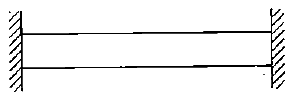A rod is fixed between two points at 20∘C. The coefficient of linear expansion of material of rod is 1.1×10−5/.C and Young's modulus is 1.2×1011N/m. Find the stress develop in the rod if temperature of rod becomes 10∘C
1.32×107N/m2
1.10×1015N/m2
1.32×108N/m2
1.10×106N/m2
The correct Answer is:A
To solve the problem, we need to find the stress developed in a rod when the temperature decreases from 20°C to 10°C. The stress can be calculated using the formula derived from Young's modulus and the linear expansion of the rod.
1. Identify the Given Data:
- Coefficient of linear expansion, α=1.1×10−5°C−1
- Young's modulus, Y=1.2×1011N/m2
- Initial temperature, T1=20°C
- Final temperature, T2=10°C
2. Calculate the Change in Temperature:
ΔT=T2−T1=10°C−20°C=−10°C
3. Calculate the Change in Length Due to Temperature Change:
The change in length ΔL due to temperature change can be expressed as:
ΔL=L⋅α⋅ΔT
Since ΔT=−10°C:
ΔL=L⋅(1.1×10−5)⋅(−10)=−1.1×10−4L
This indicates that the rod would want to contract by 1.1×10−4L.
4. Since the Rod is Fixed:
The rod cannot contract because it is fixed between two points. Therefore, the stress developed in the rod is due to this inability to change length.
5. Using Young's Modulus to Find Stress:
The stress σ developed in the rod can be calculated using the relationship:
σ=Y⋅ΔLL
Substituting ΔL:
σ=Y⋅−1.1×10−4LL=Y⋅(−1.1×10−4)
σ=1.2×1011⋅(−1.1×10−4)
6. Calculate the Stress:
σ=1.2×1011⋅−1.1×10−4=−1.32×107N/m2
The negative sign indicates that the stress is compressive.
7. Final Result:
The stress developed in the rod is:
σ=1.32×107N/m2
- Coefficient of linear expansion, α=1.1×10−5°C−1
- Young's modulus, Y=1.2×1011N/m2
- Initial temperature, T1=20°C
- Final temperature, T2=10°C
ΔT=T2−T1=10°C−20°C=−10°C
The change in length ΔL due to temperature change can be expressed as:
ΔL=L⋅α⋅ΔT
Since ΔT=−10°C:
ΔL=L⋅(1.1×10−5)⋅(−10)=−1.1×10−4L
This indicates that the rod would want to contract by 1.1×10−4L.
The rod cannot contract because it is fixed between two points. Therefore, the stress developed in the rod is due to this inability to change length.
The stress σ developed in the rod can be calculated using the relationship:
σ=Y⋅ΔLL
Substituting ΔL:
σ=Y⋅−1.1×10−4LL=Y⋅(−1.1×10−4)
σ=1.2×1011⋅(−1.1×10−4)
σ=1.2×1011⋅−1.1×10−4=−1.32×107N/m2
The negative sign indicates that the stress is compressive.
The stress developed in the rod is:
σ=1.32×107N/m2
Topper's Solved these Questions
Similar Questions
A uniform copper rod of length 50 cm and diameter 3.0 mm is kept on a frictionless horizontal surface at 20∘C. The coefficient of linear expansion of copper is 2.0×10−5K−1 and Young's modulus is 1.2×1011N/m2. The copper rod is heated to 100∘C, then the tension developed in the copper rod is
View SolutionA steel rod of length 5m is fixed between two support. The coefficient of linear expansion of steel is 12.5×10−6/∘C. Calculate the stress (in 108N/m2) in the rod for an increase in temperature of 40∘C. Young's modulus for steel is 2×1011Nm−2
View Solution
Knowledge Check
The coefficient of linear expansion of a metal rod is 12×10−6/0C, its value in per ^(0)F
A203×10−6/0FB154×10−6/0FC21.6×10−6/0FD12×10−6/0FA uniform rod of cross-section 4mm2 is heated from 0∘C to 10∘C. The coefficient of linear expansion of the rod, ∝=12×10−6/∘C and Young's modulus =1011N/m2. The strain produced in the rod is
A8×10−4B12×10−4C8×10−5D12×10−5A uniform metal rod of 2mm2 area of cross section is heated from 0∘C to 20∘C. The coefficient of linear expansion of the rod is 12×10−6/∘C. Its Young's modulus of elasticity is 1011N/m2, then the energy stored per unit volume of rod is,
A1440J/m3B2880J/m3C1200J/m3D3880J/m3
A metal rod of cross-sectional area 10−4m2 is hanging in a chamber kept at 20∘C with a weight attached to its free end. The coefficient of thermal expansion of the rod is 2.5×10−6K−1 and its Young's modulus is 4×1012N/m2. When the temperarure of the chamber is lowered to T then a weight of 5000 N needs to be attached to the rod so that its length is unchanged. Then T is
View SolutionThe coefficient of linear expansion of iron is 0.000011.∘C. An iron ro is 10 metre long at 27∘c. The length of the rod will be decreased by 1.1 mm when the temperature of the rod changes to
View SolutionFigure shows a steel rod of cross sectional ara 2×10−6m2 is fixed between two vertical walls. Initially at 20∘C there is no force between the ends of the rod and the walls. Find the force which the rod will exert on walls at 100∘C. Given that the coefficient of linear expansion of steel is 1.2×10−5.∘C−1 and Young's modulus is 2×1011N/m2

View SolutionAt temperature T, length of rod is L. If coefficient linear expansion of material of rod is 2×10−2/.∘C then length of rod when temperature of rod increased by 25∘C is
View SolutionA uniform metal rod fixed at its ends of 2mm2 cross-section is cooled from 40∘C to 20∘C. The coefficient of the linear expansion of the rod is 12×10−6 per degree celsius and its young's modulus of elasticity is 1011N/m2. The energy stored per unit volume of the rod is
View Solution